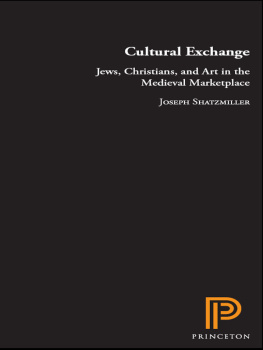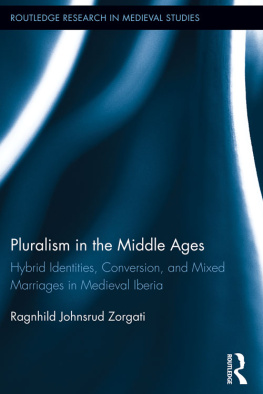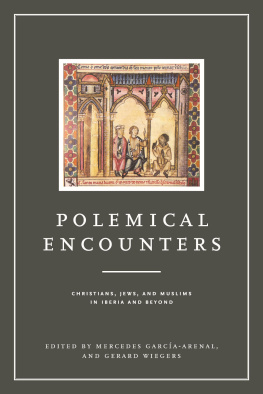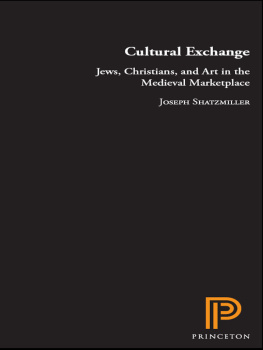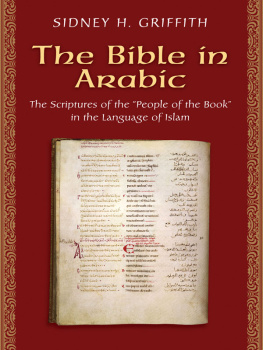
CULTURAL EXCHANGE
___________________________________
Jews, Christians, and Muslims from the Ancient to the Modern World
William Jordan, Michael Cook, and Peter Schfer, series editors
Edited by Michael Cook, William Chester Jordan, and Peter Schfer
A list of titles in this series appears at the back of the book.
CULTURAL EXCHANGE
________________________________
Jews, Christians, and Art in the Medieval Marketplace
Joseph Shatzmiller
PRINCETON UNIVERSITY PRESS
Princeton and Oxford
Copyright 2013 by Princeton University Press
Published by Princeton University Press, 41 William Street, Princeton, New Jersey 08540
In the United Kingdom: Princeton University Press, 6 Oxford Street, Woodstock, Oxfordshire OX20 1TW
press.princeton.edu
All Rights Reserved
Jacket Art: Initial E: A Man Receiving a Purse from a Jew in Exchange for a Goblet (83.MQ.165.114). Artist: Unknown, Possible Michael Lupi de Candiu, about 12901310. Courtesy of the Getty Museum.
Library of Congress Cataloging-in-Publication Data
Shatzmiller, Joseph, author.
Cultural exchange : Jews, Christians, and Art in the medieval marketplace / Joseph Shatzmiller.
pages cm. (Jews, Christians, and Muslims from the ancient to the modern world)
Includes bibliographical references and index.
ISBN 978-0-691-15699-6 (hardcover : alk. paper) 1. JewsEurope, WesternCivilization. 2. JewsEurope, WesternSocial life and customsTo 1500. 3. ChristiansEurope, WesternCivilization. 4. ChristiansEurope, WesternSocial life and customsTo 1500. 5. Europe, WesternCivilizationTo 1500. 6. Europe, WesternCivilizationJewish influences. 7. Europe, WesternEthnic relations. I. Title.
DS135.E81S53 2013
381.108992404dc23 2012046441
British Library Cataloging-in-Publication Data is available
Publication of this book has been aided by a grant from Duke Universitys History Department; the incorporation of the illustrations has been supported by a grant from The Lucius N. Littauer Foundation
This book has been composed in Sabon
Printed on acid-free paper.
Printed in the United States of America
10 9 8 7 6 5 4 3 2 1
Contents
___________
List of Illustrations
__________________________
F IGURE 4. Egyptians presenting Israelites with gifts on the eve of the Exodus. The John Rylands Haggadah, fourteenth century.
John Rylands Library, Manchester, England, Ms. 6, fol. 18r. |
| family of Rabbi Moses of Zurich (c. 1330), Brunngasse No. 8, Zurich. Also noticeable are several coats of arms possibly belonging to clients of the family. |
F IGURE 12. The daughter of the Pharaoh and her attendants recover the baby Moses from the Nile. All faces are blank. The illustration is from the First Yahudah Haggadah, produced in Franconia, southern Germany, between 1470 and 1480 by an unidentified scribe. It is handwritten on parchment with brown ink, gold leaf, and silver leaf, in square Ashkenazic script.
H: 23.1 cm; W: 16.5 cm. |
| F IGURE 16. The frontispiece of the Worms Mahzor, which was perhaps illuminated by a Jew (fol. 237v). The body of the person is of normal proportions while his head is that of a bird. This mahzor has two parts, the first completed on the first day of 1272. |
| F IGURE 23. A page of an illustrated Haggadah, illuminated by Joel ben Simon, a fifteenth-century scribe and painter. The compressed bodies of the five men do not detract from the beauty of the piece. The presentation of the faces of the five sages, and of other people in his works, is executed with confidence. |
Preface
_______________
In writing this book I have tried to simplify the narrative as much as possible in order to facilitate the reading of its seven chapters. For this reason I have tried to reduce the volume of scholarly apparatus, perhaps less successfully than anticipated. Footnotes have been shortened to the most essential elements, but will send the curious reader to a more detailed bibliography.
For the sake of simplification, almost all quotations and references are given in English, not Hebrew or Latin. In the majority of cases I have had access to reliable translations. When an alternative interpretation of a term or a sentence is possible, I have included that in brackets.
In an effort to avoid the readers having to struggle with an avalanche of references, I have, when presenting a continuous set of data drawn from the same source, provided the reference within the text itself, not in the footnotes. The item number or the page number is given in parentheses. References to call numbers (signatures) of codices and folios of manuscripts are also included parenthetically in the text rather than in the footnotes. In several instances, when the title of a printed book made part of the discourse of a paragraph, I quoted its title in full in the text and provided also the bibliographical reference instead of relegating it to a note.
This book has been generously supported by the Department of History, Duke University, and by the Lucius N. Littauer Foundation, New York. I wish also to express thanks to the libraries that provided permission to publish illustrations from their collections and especially to those who generously waived the fee or provided an educational discount. All credits are mentioned in the captions that accompany each of the illustrations.
Larissa Klein, editorial assistant at Princeton University Press, worked with me for almost a year providing advice and helping with the onerous task of collecting permissions to publish illustrations from many different sources. We had close to daily contact struggling to achieve the permissions. Her efforts and successes can serve as an example of patience, perseverance, and efficiency. Dr. Brigitta van Rheinberg, editor-in-chief and executive editor of Princeton University Press, including its Judaica series, took an avid interest in my manuscript from the first minute and navigated its course within the different committees with much sympathy and understanding. Her wise suggestions helped shape the story and make it more effective. To both I send my heartiest thanks. Special thanks to Debbie Tegarden who worked with grace and efficiency on the final version of this book. Many other friends and colleagues have helped me during the many years that I worked on this project. They will find their names and my thanks in the notes.
This book took a long time to write. Still, without the help, so generously given by these friends, it would have taken even longer. Let me extend my thanks to my wife Gayle Murray, who in many hours of hard work tried to make sense of my English and saw to it that I followed the rules of logic. The least I can do is dedicate this book to her.
CULTURAL EXCHANGE
_____________________________________
INTRODUCTION
__________________________
This book is about the cultural exchange between Jews and Christians in the High and Late Middle Ages (c. 12301450 CE). Members of each group contributed to the others culture, even to their religious practices. The Christian protagonists appear more frequently in most chapters, but Jews, too, are handsomely represented. My interest in these people and their endeavors was raised while I was working on the history of the West European marketplace and its financial services. Moneylenders, Jews and non-Jews, could not always count on notarized contracts to secure the loans they were extending, and required tangible objects as collateral. They became, in fact, pawnbrokers. This fact led me to undertake the present project.
Next page
